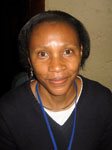Women still hitting glass ceiling in media

Gertrude Makhafola has been a journalist at the Sowetan for two years. She first joined AVUSA Limited as an intern, started at Business Day, then moved to Sowetan Business and finally to cover general news. Makhafola is passionate about journalism, “I love being a journalist,” she says. “I was in the public service for three years; then I took a pay cut and joined AVUSA.”
Enthusiasm not matched

Makhafola, like many other women in media, often find their enthusiasm for the craft not matched by support and opportunities within newsrooms and media houses. Many interviewed for the research cited gender discrimination, including harassment, as a problem in the industry.
“If you come to work one day wearing a skirt or heels, your male colleagues will make statements like ‘I didn't know you have those assets!' explained Makhafola. “This goes on everyday and it goes beyond simple compliments...” The research also found that perceptions that women cannot, or should not, cover certain beats or take on certain roles, discourages them from joining, and staying, in the media field.

There are wide discrepancies among countries of how far nations' have progressed when it comes to gender equality in the media. At the top end of the scale, the tiny country of Lesotho has the largest percentage of women (73% women compared to 27% men) employed in media houses, followed by South Africa with equal percentages of women and men (50/50). Seychelles, with 49% women, is a close third.
At the other end, four countries are below the one-third mark. These are Mozambique (27%); Malawi (23%); Democratic Republic of Congo (DRC - 22%) and Zimbabwe (13%), though the Zimbabwean state broadcaster, the largest employer, did not participate in the study, which may have skewed the figures.
Overall regional average
At 41%, the overall regional average for women in the media is respectable. However, when SA (which has by far the largest media density) is taken out of the equation, the figure falls to 32%.
The research also found that when it comes to positions of authority, the gender gap widens. On average, women are only 28% of those in senior management positions in the region, pointing to where they meet their first challenge of breaking into the higher echelons of media management.
Without women in these top positions, media houses are missing the full picture when it comes to reporting the news. Calsile Masilela, a community reporter from the Swazi Observer, said, “If there were women in decision-making roles, content would change. There would be more women sources. But most of the time you find that we are not in managerial positions.”
The research also found that the gender division of labour in beats is still pronounced. Male journalists dominate in those areas of coverage considered “hard beats” such as investigative/in-depth reports (80%), sports (76%) and political stories (75%). Women journalists predominate in coverage of gender equality and gender violence (71% each) and health (59%).
In the hands of men
The actual production of media is also largely in the hands of men, who dominate in the editorial (58%), design (69%), production (70%), printing and distribution (76%) and technical/IT (84%) departments in the region's media houses. Women, however, are more numerous in areas considered to be “women's work” (clerical and administrative support) in the finance and administration (54%), advertising/marketing (57%) and human resources (44%) departments.
Several journalists interviewed commented on how women who start out in the media, end up in communication-related fields other than the mainstream media. Natasha Uys, a journalist at The Namibian, said, “Most women who study media opt for safer options like PR.”
Many media women cite balancing the long and erratic working hours of media with the expectations of family responsibilities to be a major challenge. In Swaziland, media women and men interviewed cited tradition and culture as barriers to women's access and participation in the media.
Setsable Sibisi, head of current affairs and a senior journalist at Swazi TV, explained the situation, “There are certain restrictions like where a woman can't go etc. So our traditions are restrictive to women....”
Stewart Tsela, editor at Radio Swaziland added, “The restrictions are more from the traditions, not necessarily from the media house. It is unspoken - it is within us as Swazis.”
“Equal to prostitution”
Another respondent commented, “Many women find it difficult to balance family responsibilities with working as a journalist. This is made even more difficult when a woman is married to a man who has difficulty accepting that the job may require some time spent away from home. Often women in journalism are not respected by men, who think girls working in journalism are equal to prostitution.”
Perhaps one respondent summed up the problems women in media face best, when he said, “We expect women to be home at 6pm cooking, and not at press conferences mingling with ministers.”
Despite an often unfriendly working environment, there is a growing appreciation in some circles that having a critical mass of women in newsrooms makes for better media. Women and men interviewed for the Glass Ceiling research gave several examples of how having women in the media, especially at a senior level, changes newsroom culture and impacts positively on coverage.
Good for democracy, good for business
A number of media managers interviewed stressed that gender balance in the media is not only good for democracy, but also good for business. Ichikaeli Maro, sub-editor of weekend publications at TSN in Tanzania noted, “Women are good for business because the nature of stories they do brings increased readership, especially women readers.”
Despite the challenges, in every country there are inspiring examples of strong women leaders such as Gwen Lister, editor of The Namibian; Ferial Haffajee, editor of City Press and former editor of the Mail & Guardian, and Pauline Banda, known as “Miss Beijing” for her hard-hitting gender column in the Zambia Daily Mail. All of these women have forged ahead and succeeded in the male-dominated media industry.
This study on gender employment patterns in media houses took place in the context of the August 2008 SADC Protocol on Gender and Development, which urges the media and all institutions in the public and private sectors to achieve gender parity in decision-making positions by 2015.
The Gender Protocol also calls for the mainstreaming of gender in all media laws, policies and training. It urges the media to give equal voice to women and men; challenge gender stereotypes; and, ensure balance and sensitivity in all coverage, especially that relating to gender violence.
As this research shows, if media are to reach the target outlined in the protocol, urgent action is needed to transform not only policies and procedures, but also media house culture. After all, women represent over half the population, and so should represent half the voices.
- The media sector is largely a male-dominated industry in the region, with men constituting 59% of the employees in media houses compared to 41% women.
- Only two countries have achieved the parity target - Lesotho has the largest percentage of women (73% women compared to 27% men) employed in media houses, followed by SA with equal percentages of women and men (50/50).
- Women constitute a little over a quarter of the directors on media house boards and less than a quarter of top management.
- Only 23% of the top managers in media houses in southern Africa are women. The only country in the region with 50% or more women in top management is Lesotho (56%), followed by Namibia with 42% women in top management. Only 11% of the top managers in Zambia are women, and Seychelles, the lowest, has no women in top management.
- None of the media houses in the study could point to specific targets for ensuring gender equality in decision-making positions in line with the SADC Gender Protocol 2015 parity target. Several media houses in Namibia, Lesotho and SA have 50% women or more, but many of these women are located in support as opposed to key decision-making posts.
- A large percentage of the media houses (81%) offer maternity leave, but not paternity leave (only 33% of the media houses).
- Only 16% of media houses surveyed said that they have gender policies and often these could not articulate what the gender policy consists of.
- Six of the 11 media in the sample have more than 50% women. The other five have between 42% and 49% women.
- These figures are not mirrored at management level - women remain under represented in boards of directors (38%), top management (25%) and senior management (35%).
- Women (61%) are more likely than men (39%) to be employed in part time positions and 56% of women are employed on a non-permanent basis. The regional average for women in part time positions is 23% and 36% for non-permanent employment. This reflects a much higher level of job insecurity for women in the SA media.
- Women in the SA media pre-dominate in HR (74%); advertising/marketing (61%) and finance and administration (59%). These areas are considered to be “women's work.” In the region women dominate in finance and administration (54%) and in advertising/marketing (57%).
- In SA 52% of those in the editorial departments in media are women; this is higher than the regional average of 42%.
- The research showed some interesting gender benders in some beats - women (83%) dominate economics/business/finance. The difference in the proportion of women (40%) and men (60%) in sports reporting is not as wide as in the region, 24% for women and 76% for men.
- In the SA sample, 91% of the media houses offer maternity leave; this is higher than the regional average of 81%. Only 64% of SA media houses have paternity leave, higher than the regional average of 33%.
- Only 9% of the media houses in SA stated that they have gender policies; 82% have sexual harassment policies and 64% of media houses showed interest in developing or improving an existing gender policy. Only 16% of media houses in the region said they had gender policies while 28% said they had sexual harassment policies.














